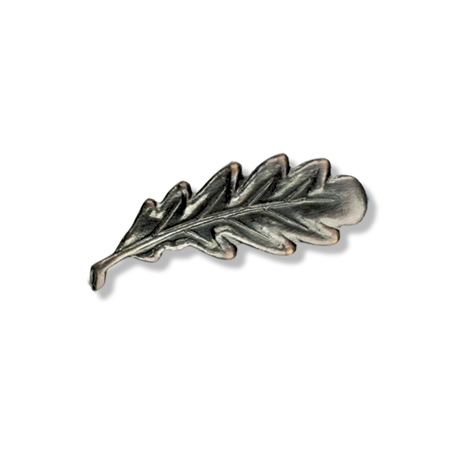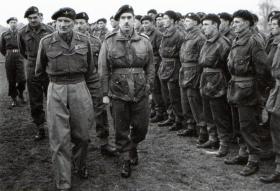William (or Bill as he more commonly known) was born in 1913, and by 1938 had finally qualified as a doctor in Glasgow. He undertook a number of junior doctor positions until called up for service with the Royal Army Medical Corps.
By 1941, Bill was serving with 133 Field Ambulance RAMC, originally a TA unit recruiting from the Croydon area, which supported the 44th (Home Counties) Division for many years, including with the British Expeditionary Force (BEF) in France in 1939 and 1940. 133 Field Ambulance RAMC continued to accompany this formation when it was despatched to the Middle East in 1942, and saw action in the Western Desert and at El Alamein. The 44th Division was disbanded after El Alamein, but 133 Field Ambulance survived and was moved first to Syria and later to Kabrit in the Canal Zone in Egypt.
It was here in January 1943 that the unit joined Airborne Forces, converted to a Parachute Field Ambulance to form part of the newly-raised 4th Parachute Brigade alongside 10th and 156th Parachute Battalions. By April 1943, the 4th Parachute Brigade was camped near the aerodrome at Ramat David, not far from Nazareth in Palestine. Various Brigade exercises took place, one which injured the CO of 133 Para Fd Amb, Lt Col Scriven, who broke his ankle and was posted.
Bill Alford, who had been the Second-in-Command (2-i-c) was promoted and assumed command of the unit. From these early days, Bill took the unit to Italy in September 1943, remaining there until the 1st Airborne Division was recalled to the UK. For his services in Italy he was awarded the OBE and also an Mention in Despatches.
After months training with the rest of 1st Airborne Division in preparation for the next operation to North West Europe, the Division was finally sent in to action at Arnhem, during Op Market Garden. In September 1944, Bill led the 129 officers and men of his unit to Holland. Supporting the 4th Parachute Brigade they landed around 1500hrs during the Second Lift on 18 September on Ginkel Heath DZ Y, about 9 miles north west of Arnhem.
Once on the ground, the operation did not go well on the first day for 133 Para Fd Amb. Their proposed RV point was held by the Germans and had to be cleared. With the DZ under fire for a time, many drop zone casualties had to be collected and treated. Perhaps worse still, at the roll call about 40 men were missing. Some turned up later but several sticks had been dropped away from the DZ and never managed to reach their unit at Arnhem. Nevertheless, Bill Alford and the 133 had to make the best of their situation. First, they set up a MDS in the Zuid Ginkel café, then on 19 September they supported the 4th Parachute Brigade in its efforts to reach the Arnhem road bridge, and treated many casualties during this day working from a CCP (Casualty Collecting Point) set up under a bridge. Bill Alford also managed to go on a recce to Oosterbeek to select a location to set up a dressing station which was located on the Utrechtseweg close to the Vreewijk Hotel.
On the 20 September these buildings were shelled and it was decided to move and as Bill’s report written later put it:
‘At approx. 2000 hours CO reported to ADMS who ordered a new dressing station to be opened in a house facing the river called Pietersberg. With the same staff i.e. CO, Captain Huddleston, Captain Flockhart and about ten orderlies. This dressing station was prepared during the early hours of 21st September and before dawn our first casualties were received. An operating theatre was opened in a room of the house on the ground floor. Cases of urgency, haemorrhage, amputations, etc. were done here for the following five days. Owing to the situation no evacuation was possible from now on.’
The conditions in this largish house (which is still standing today), a former office, must have been grim. Medical supplies, food and water were in short supply and the building was under fire on many occasions. A flavour of this can be obtained from his report for the last two days of the operation:
'25th September 1944.
Still no water. Supplies from neighbouring houses finished. Very few supplies left. Wounded now totalled 160. Working under very difficult conditions. Building hit several times. Rain came on and sufficient water was obtained from drainpipes and collected in a bath. The enemy entered the dressing station today.
26th September 1944.
The evacuation across the river carried out in the early hours. In the forenoon all casualties evacuated by enemy to Apeldoorn.'
With an Allied evacuation of the Medical stations impractical, Bill and the remnants of 133 stayed after the the 1st Airborne evacuation on the night of 25-26 September, and were captured and evacuated to Apeldoorn, where Bill helped to run the Airborne Hospital there. As a senior Medic, Bill took charge of the Medical Wing until early October.
On Thursday 5 October 1944, orders were received that a further 500 patients were to leave with three hours notice. Col Zingerling and Col Warrack went down to the railway station to inspect the train and this time it was a proper ambulance train with two German doctors and some nurses. This train was filled with three tier bunks on both sides of the carriages, there was a stove and a toilet available in every car. In addition a cookhouse, operating theatre and accommodation for the staff were provided. British medical personnel were needed to accompany the wounded, and Col Warrack took the decision to send Lt-Col Alford as OC Train, and all the remaining officers and men from the two Parachute Brigades. The Germans also requested two padres and a dentist to travel.
However once the train was loaded it had to remain at Apeldoorn station overnight due to the success of the RAF attacks on the railways. The hospital train was parked next to a German flak train which started firing when an RAF flight of Typhoons attacked the adjacent sidings and marshalling yards. The Germans fired their guns to a chorus of shouts and jeers from the Airborne wounded. It was hoped their jeers had put the gunners off their aim, and it appeared that no aircraft were hit.
However the incident caused a strong protest from Lt-Col Alford. He was concerned the Germans appeared to abuse the protection of the Red Cross to carry out offensive action, in contravention of the Geneva Convention. When Col Zingerling heard of the incident, he was furious and complained strongly to the local commander. The flak train was removed.
This hospital train however was forced to remain at Apeldoorn for three days before leaving due to the RAF attacking rolling stock and railway lines and additionally the Dutch railway workers were in the middle of a strike.Bill remained in German hands until liberated towards the tail-end of the war. He quickly rejoined the reforming 133 Para Field Ambulance, and in May 1945 went to Norway with the 1st Airborne Division to help disarm the numerous German troops stationed there. After returning to the UK in late Autumn 1945, 133 PFA was finally disbanded in December 1945. Shortly afterwards, Bill received a Mention in Despatches for his actions at Arnhem.
On leaving the Services, Bill Alford returned to being a family doctor in a single-handed general practice in Lairg, Sutherland in the Scottish Highlands. He remained there until his retirement in June 1983 and died in March 1990.
Further reading:
Niall Cherry, Red Berets and Red Crosses (1999), Robert Sigmond LtdWith assistance from Niall Cherry
Read More


Latest Comments
There are currently no comments for this content.
Add Comment
In order to add comments you must be registered with ParaData.
If you are currently a ParaData member please login.
If you are not currently a ParaData member but wish to get involved please register.